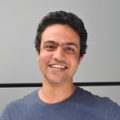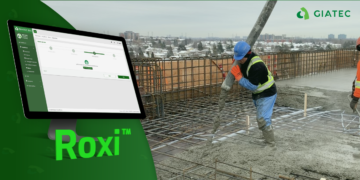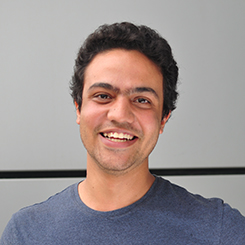In late 2020, Giatec announced that our artificial intelligence (AI) program RoxiTM has been trained with the funding provided by Sustainable Development Technology Canada (SDTC), which will help in the reduction of cement usage during concrete testing. For those that are unfamiliar with Roxi’s functions, require deeper insights into how and why this funding came about, or are curious about the approach Giatec takes towards AI in the concrete industry, we encourage you to dive right into this blog post. Make sure to check out other linked resources throughout the article to learn more about the fantastic potential of AI technology at construction jobsites as well as for sustainability!
Explore 12 Futuristic Technology Trends Solving Concrete's Biggest Challenges.
What is Roxi?
Roxi is the first AI algorithm created for concrete testing and was developed in conjunction with the Montreal Institute of Learning Algorithms (MILA), Quebec’s World-Renowned Artificial Intelligence Institute. Roxi provides new insights into concrete performance by using machine learning. Some of its applications include optimizing concrete mixtures, reducing cement usage, reducing concrete’s CO2 footprint, predicting concrete properties and proactively detecting anomalies in concrete performance and testing. Roxi does all this and more by evaluating the concrete mixture proportions, ambient conditions, raw material characteristics and construction practices to provide producers and contractors with insights and analytics into concrete production and usage.

Roxi, however, doesn’t work alone. Accompanied by our SmartRock® wireless sensors and SmartMixTM, web-based dashboard, Roxi has access to millions of data points as a result of being used in over 8,000 construction projects worldwide. This brings us into the next crucial question: What Is SmartMix?
SmartMix: AI-Based Concrete Mix Optimization and Performance Prediction
SmartMix is a web-based dashboard that enables producers to make use of Roxi’s skills in optimizing concrete materials and predicting the performance of their mixes. With the SmartMix dashboard, producers can adjust the proportions of their concrete mixes, such as changing the water-to-cementitious material ratio, cement content, supplementary cementitious materials content, chemical admixtures usage, etc. and predicting how such changes influence the concrete performance. With the help of Roxi, SmartMix’s suggestions ensure that these adjustments will meet a mix’s designed compressive strength and other performance criteria. Integrating Roxi with other concrete data management platforms using our comprehensive REST API will help users gain access to more insights into the quality control and quality assurance of concrete.
How Does SmartMix’s AI Dashboard Work?
SmartMix’s algorithm, Roxi, makes use of neural networks. Neural networks are a branch of machine learning and deep learning. These are computational systems that are thought to loosely mimic the biological neural networks. These are large collections (thousands or even millions) of processing nodes that are interconnected. Modern neural networks are organized into layers of nodes with data moving through them in one feed-forward direction (from input to output). An individual node might be connected to several nodes in the layer beneath it, from which it receives data, and several nodes in the layer above it, to which it sends data. A schematic of such networks is shown in Fig. 1:
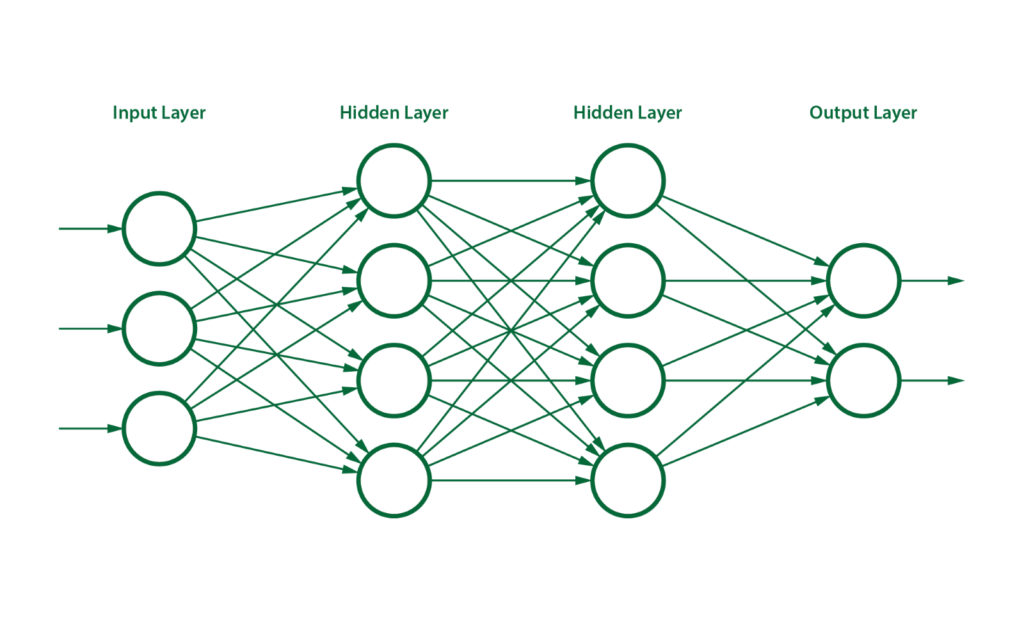
A node combines inputs with a set of coefficients (often termed weights) that assign significance to inputs with respect to the task the algorithm is trying to learn. These input-weight products are summed and then the sum is passed through a node’s activation function, to determine whether, and to what extent, that signal should progress to affect the ultimate outcome. A node layer is a row of those neurons/nodes. Each layer’s output is the following layer’s input, from the input layer (e.g., concrete mixture) all the way to the desired output (e.g., concrete strength).
When a neural net is undergoing a process termed “training”, all of its internal coefficients are initially set to random values. Training data is fed to the input layer and output layer. This data is usually well-labeled historically collected data where the algorithm has access to both inputs and outputs (e.g., historical concrete mixture proportions and mix performance). During training, the weights and thresholds are continually adjusted and model evaluation criteria (e.g. the accuracy of determining strength) are monitored, until the network’s coefficients are deemed optimum when the model evaluation criteria is optimized.
Since neural networks can have thousands or even millions of inputs, outputs, layers, nodes and coefficients, these systems can be used to simulate many complex tasks. These tasks can range from classifying images of cats and dogs, to predicting the probability of an occurrence of a disease to an individual, to predicting concrete performance to managing a self-driving car; with the opportunities being virtually unlimited for well-defined tasks with available data for algorithm training and evaluation.
Click here to read more about SmartMix and its several functions!
Why did the need for AI-based programs like Roxi and SmartMix come about in the construction industry? What major issues within our conventional methods is artificial intelligence providing solutions to?
The Rationale for AI-Based Programs in the Concrete Industry
The construction industry is one that is contributing a significant amount of CO2 emissions. Cement alone contributes 8% of Global Greenhouse Gas (GHG) emissions. Part of the problem stems from the overuse of cement in concrete proportioning. Most commonly, when concrete mixtures are designed to meet a specific performance criteria, these mixtures are over-designed to account for the variables that influence concrete performance.
A significant part of this over-design is caused by unpredictable events. Typically, concrete is manufactured in an outdoor environment, without the luxury of having sophisticated plants that are temperature, pressure, and humidity controlled. The process often includes mixing raw materials, loading them into a truck, dispatching them in a job site under the mercy of many variables (e.g. traffic, rain, fluctuating temperatures, etc.). The material is nevertheless expected to meet some rigorous criteria, regardless of the influencing conditions, whether it’s compressive strength or concrete slump or its air content or its volume stability. Subsequently, mixtures are overdesigned to ensure that regardless of these influencing conditions, the performance is met. Giatec’s algorithms have the ability to simulate these systems and being able to predict the expected performance criteria for specific mixtures and environments, which allows users to optimize mixes for their specific use-case. Knowing how the process works and how certain raw materials or weather conditions affect the performance of concrete, and being able to predict the performance putting into consideration all of these influencing variables, can aid users in continuously going back and reoptimizing the mixture on a case-by-case basis, thereby reducing costs, and decreasinge carbon emissions as well.
This is where SmartMix and its significant amounts of data comes in. Roxi has been trained using the biggest data set that’s available for concrete performance thanks to our SmartRock sensors and our SmartRock Plus partners. It’s a global dataset that exposes the algorithm to information about how concrete performs in different environments. The algorithm used in this program predicts the performance of the concrete, looking into its ambient conditions or its raw materials characteristics. With this algorithm, for instance, we can predict the amount of cement reduction by observing how the weather is to change for the following day. Similarly, if not weather, the variable could include a change in humidity, or equipment, or the curing method.
In order to demonstrate the capabilities of the algorithm, Figure 2 shows CO2 footprint (obtained from Environmental Product Declarations) of 5000 mixtures produced in the US, Canada and European markets (from Giatec’s dataset) as well as the National Ready Mixed Concrete Association (NRMCA) benchmark, versus algorithmic suggestions for mixtures to meet the same compressive strength classes as that in the NRMCA benchmark. The algorithm suggestion datapoints are averages of algorithm recommendations for all producers with data included in the figure. Although this is simplified for demonstration as other design criteria (durability, slump, shrinkage, etc.) can govern mixture proportioning, it is evident that Roxi can enable a significant reduction to concrete footprint for the same strength classes.
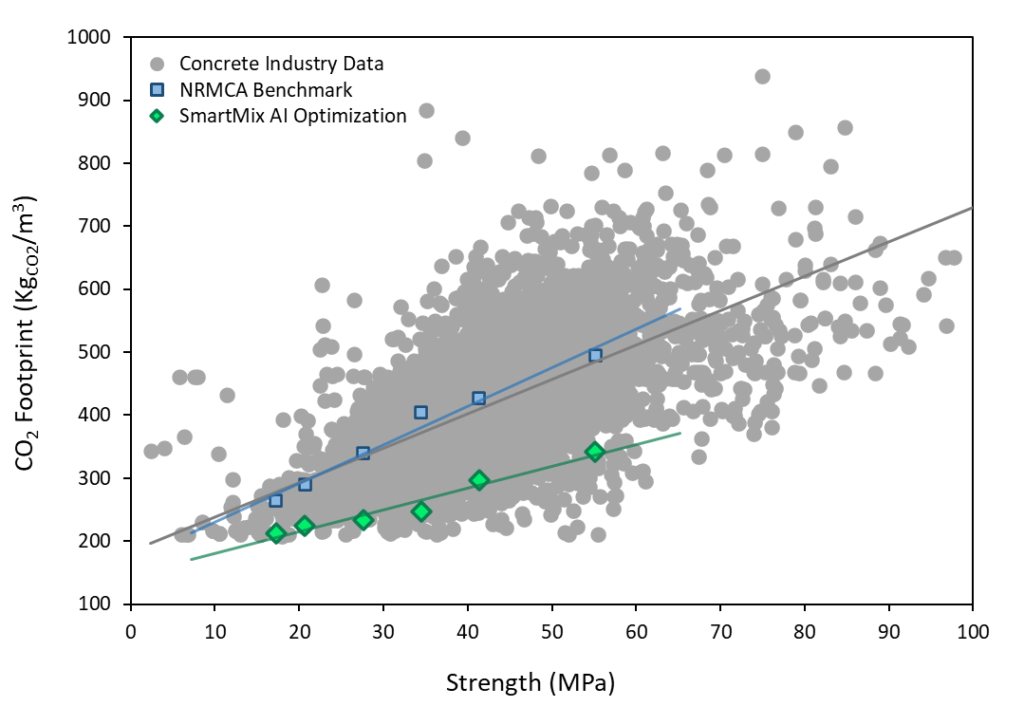
Why Roxi Is Special
Over the course of the program’s development, Roxi has proven itself to be a high performer in the realm of sustainability and technological advancement. The funding of a total of $2.4 million, which is a part of the $58.6 million investment that SDTC made in Canadian clean technology companies, subsequently supports the research, development, and training of Roxi. Alongside the funding from SDTC, Roxi has also received $800,000 from the National Research Council of Canada Industrial Research Assistance Program (NRC IRAP) to support the research and development of its applications. About Roxi’s sustainability-promoting properties, Leah Lawrence, President and CEO of SDTC, says: “Roxi is the type of cutting-edge technology that has the power to make significant environmental impacts by reducing cement usage while also being a cost-effective tool for construction jobs. We are proud to support the development of this novel AI-enabled cleantech, and to make sure Roxi gets the best training”.
With the need for less cement, Roxi’s features help decrease the cost of concrete mixtures and improve profitability for producers, thereby resulting in the reduction of CO2 emissions from the manufacturing of concrete. Roxi was built for and works in conjunction with Giatec’s award-winning SmartRock wireless sensors, a companion product that lead to Roxi’s recognition. Increasingly, clean technology companies like Giatec are prioritizing the advancement of sustainable practices and are placing artificial intelligence at the forefront of some of these developments. Giatec’s AI-based programs are an active participant in a substantial effort to curb environmental degradation through excessive CO2 emissions. With the new research and data regarding Roxi’s performance at hand, we aspire to propel this vision forward and to work towards a cleaner, environmentally conscious, and more sustainable construction industry.
